A Novel Rare Earth and Covalent Organic Framework Composite for Rapid and Highly Sensitive Electrochemical Analysis of Sulfadiazine in Fish Muscle
Abstract
:1. Introduction
2. Experimental Section
2.1. Materials and Reagents
2.2. Preparation of COFTDBA-TTL
2.3. Preparation of SmV/COFTDBA-TTL
2.4. Preparation of SmV/COFTDBA-TTL/GCE
2.5. Detection of Actual Samples
2.6. Instruments
3. Results
3.1. Characterization of Composite Materials
3.2. Electrochemical Behaviors of the SmV/COFTDBA-TTL/GCE Modified Electrode
3.3. SFZ Detection Based on the SmV/COFTDBA-TTL/GCE Modified Electrode
3.4. Selectivity, Repeatability and Stability of the SmV/COFTDBA-TTL/GCE Modified Electrode
3.5. Analysis of Real Samples
4. Conclusions
Supplementary Materials
Author Contributions
Funding
Institutional Review Board Statement
Informed Consent Statement
Data Availability Statement
Conflicts of Interest
References
- Luo, Y.; Xu, L.; Rysz, M.; Wang, Y.; Zhang, H.; Alvarez, P.J.J. Occurrence and transport of tetracycline, sulfonamide, quinolone, and macrolide antibiotics in the haihe river basin, china. Environ. Sci. Technol. 2011, 45, 1827–1833. [Google Scholar] [CrossRef] [PubMed]
- Liu, X.; Steele, J.C.; Meng, X.Z. Usage, residue, and human health risk of antibiotics in Chinese aquaculture: A review. Environ. Pollut. 2017, 223, 161–169. [Google Scholar] [CrossRef] [PubMed]
- Ye, C.; Shi, J.; Zhang, X.; Qin, L.; Jiang, Z.; Wang, J.; Li, Y.; Liu, B. Occurrence and bioaccumulation of sulfonamide antibiotics in different fish species from Hangbu-Fengle River, Southeast China. Environ. Sci. Pollut. Res. Int. 2021, 28, 44111–44123. [Google Scholar] [CrossRef] [PubMed]
- Schar, D.; Klein, E.Y.; Laxminarayan, R.; Gilbert, M.; Van Boeckel, T.P. Global trends in antimicrobial use in aquaculture. Sci. Rep. 2020, 10, 21878. [Google Scholar] [CrossRef] [PubMed]
- Zhou, X.; Deng, Y.; Wang, R.; Wang, F.; Cui, H.H.; Hu, D.Y.; Lu, P. Toxic effects of imidacloprid and sulfoxaflor on Rana nigromaculata tadpoles: Growth, antioxidant indices and thyroid hormone-related endocrine system. Arab. J. Chem. 2023, 6, 104723. [Google Scholar] [CrossRef]
- Deng, Y.; Wang, R.; Song, B.; Yang, Y.; Hu, D.; Xiao, X.; Chen, X.; Lu, P. Enantioselective bioaccumulation and toxicity of rac-sulfoxaflor in zebrafish (Danio rerio). Sci. Total Environ. 2022, 817, 153007. [Google Scholar] [CrossRef]
- Jiang, J.; Wang, L.; Zhang, C.; Zhao, X. Health risks of sulfentrazone exposure during zebrafish embryo-larvae development at environmental concentration. Chemosphere 2022, 288, 132632. [Google Scholar] [CrossRef]
- Lei, Y.; Li, F.; Mortimer, M.; Li, Z.; Peng, B.X.; Li, M.; Guo, L.H.; Zhuang, G. Antibiotics disrupt lipid metabolism in zebrafish (Danio rerio) larvae and 3T3-L1 preadipocytes. Sci. Total Environ. 2023, 858, 159755. [Google Scholar] [CrossRef]
- Velmurugan, S.; Yang, T.C.K.; Chen, S.W.; Chen, J.N. Metal-organic frameworks derived ZnO-Co3O4 pn heterojunction photocatalyst for the photoelectrochemical detection of sulfadiazine. J. Environ. Chem. Eng. 2021, 9, 106169. [Google Scholar] [CrossRef]
- Palmblad, M.; van Eck, N.J.; Bergquist, J. Capillary electrophoresis—A bibliometric analysis. TrAC Trends Anal. Chem. 2023, 159, 116899. [Google Scholar] [CrossRef]
- Rios-Reina, R.; Azcarate, S.M. How chemometrics revives the UV-Vis spectroscopy applications as an analytical sensor for spectralprint (nontargeted) analysis. Chemosensors 2023, 11, 8. [Google Scholar] [CrossRef]
- Krstic, D.D.; Ristivojevic, P.M.; Gasic, U.M.; Lazovic, M.; Aksic, M.M.F.; Milivojevic, J.; Morlock, G.E.; Milojkovic-Opsenica, D.M.; Trifkovic, J.D. Authenticity assessment of cultivated berries via phenolic profiles of seeds. Food Chem. 2023, 402, 134184. [Google Scholar] [CrossRef] [PubMed]
- Bracaglia, S.; Ranallo, S.; Ricci, F. Electrochemical cell-free biosensors for antibody detection. Angew. Chem. Int. Ed. Engl. 2023, 62, 134184. [Google Scholar]
- Tsuneishi, C.; Koizumi, Y.; Sueto, R.; Nishiyama, H.; Yasuhara, K.; Yamagishi, T.A.; Ogoshi, T.; Tomita, I.; Inagi, S. The controlled synthesis of pillar 6 arene-based hexagonal cylindrical structures on an electrode surface via electrochemical oxidation. Chem. Commun. 2017, 53, 7454–7456. [Google Scholar] [CrossRef]
- Zhang, J.; Qi, J.; Kang, S.; Sun, H.; Li, M. Hierarchical manipulation of uniform multi-nanoparticles by electrochemical coupling assembly. J. Mater. Chem. C 2015, 3, 5214–5219. [Google Scholar] [CrossRef]
- Lu, M.; Deng, Y.; Luo, Y.; Lv, J.; Li, T.; Xu, J.; Chen, S.W.; Wang, J. Graphene aerogel-metal-organic framework-based electrochemical method for simultaneous detection of multiple heavy-metal ions. Anal. Chem. 2019, 91, 888–895. [Google Scholar] [CrossRef]
- Yang, M.; Wu, X.; Hu, X.; Wang, K.; Zhang, C.; Gyimah, E.; Yakubu, S.; Zhang, Z. Electrochemical immunosensor based on Ag+-dependent CTAB-AuNPs for ultrasensitive detection of sulfamethazine. Biosens. Bioelectron. 2019, 144, 11643. [Google Scholar] [CrossRef]
- Jiang, S.; Geng, Y.X.; Liu, W.J.; Wang, Z.Y.; Zhang, C.Y. Construction of a phos-tag-directed self-assembled fluorescent magnetobiosensor for the simultaneous detection of multiple protein kinases. J. Mater. Chem. B 2022, 10, 9992–10000. [Google Scholar] [CrossRef]
- Sarabaegi, M.; Roushani, M.; Hosseini, H. Hollow carbon nanocapsules-based nitrogen-doped carbon nanofibers with rosary-like structure as a high surface substrate for impedimetric detection of Pseudomonas aeruginosa. Talanta 2021, 223, 121700. [Google Scholar] [CrossRef]
- Chen, X.; Gao, J.; Zhao, G.; Wu, C. In situ growth of FeOOH nanoparticles on physically-exfoliated graphene nanosheets as high performance H2O2 electrochemical sensor. Sens. Actuators B 2020, 313, 128038. [Google Scholar] [CrossRef]
- Rydzek, G.; Toulemon, D.; Garofalo, A.; Leuvrey, C.; Dayen, J.F.; Felder-Flesch, D.; Schaaf, P.; Jierry, L.; Begin-Colin, S.; Pichon, B.P.; et al. Selective nanotrench filling by one-pot electroclick self-constructed nanoparticle films. Small 2015, 11, 4638–4642. [Google Scholar] [CrossRef] [PubMed]
- Rodriguez-San-Miguel, D.; Montoro, C.; Zamora, F. Covalent organic framework nanosheets: Preparation, properties and applications. Chem. Soc. Rev. 2020, 49, 2291–2302. [Google Scholar] [CrossRef] [PubMed]
- Pang, Y.H.; Huang, Y.Y.; Shen, X.F.; Wang, Y.Y. Electro-enhanced solid-phase microextraction with covalent organic framework modified stainless steel fiber for efficient adsorption of bisphenol A. Anal. Chim. Acta 2021, 1142, 99–107. [Google Scholar] [CrossRef] [PubMed]
- Wu, N.; Wang, L.; Xie, Y.; Du, Y.; Song, Y.; Wang, L. Double signal ratiometric electrochemical riboflavin sensor based on macroporous carbon/electroactive thionine-contained covalent organic framework. J. Colloid Interface Sci. 2021, 162, 219–226. [Google Scholar] [CrossRef] [PubMed]
- Feng, S.; Yan, M.; Xue, Y.; Huang, J.; Yang, X. An electrochemical sensor for sensitive detection of dopamine based on a COF/Pt/MWCNT-COOH nanocomposite. Chem. Commun. 2022, 58, 6092–6095. [Google Scholar] [CrossRef] [PubMed]
- Zhang, C.; Li, W.; Liu, C.; Zhang, C.; Cao, L.; Kong, D.; Wang, W.; Chen, S. Effect of covalent organic framework modified graphene oxide on anticorrosion and self-healing properties of epoxy resin coatings. J. Colloid Interface Sci. 2022, 608, 1025–1039. [Google Scholar] [CrossRef]
- Yang, X.; Lin, C.; Han, D.; Li, G.; Huang, C.; Liu, J.; Wu, X.; Zhai, L.; Mi, L. In situ construction of redox-active covalent organic frameworks/carbon nanotube composites as anodes for lithium-ion batteries. J. Mater. Chem. A 2022, 10, 3989–3995. [Google Scholar] [CrossRef]
- Zhao, C.; Zhang, L.; Wang, Q.; Zhang, L.; Zhu, P.; Yu, J.; Zhang, Y. Porphyrin-based covalent organic framework thin films as cathodic materials for “on-off-on” photoelectrochemical sensing of lead ions. ACS Appl. Mater. Interfaces 2021, 13, 20397–20404. [Google Scholar] [CrossRef]
- Adijanto, L.; Padmanabhan, V.B.; Holmes, K.J.; Gorte, R.J.; Vohs, J.M. Physical and electrochemical properties of alkaline earth doped, rare earth vanadates. J. Solid State Chem. 2012, 190, 12–17. [Google Scholar] [CrossRef]
- Alkorbi, A.S.; Kumar, K.Y.; Prashanth, M.K.; Parashuram, L.; Abate, A.; Alharti, F.A.; Jeon, B.H.; Raghu, M.S. Samarium vanadate affixed sulfur self doped g-C3N4 heterojunction; photocatalytic, photoelectrocatalytic hydrogen evolution and dye degradation. Int. J. Hydrogen Energy 2022, 47, 12988–13003. [Google Scholar] [CrossRef]
- Li, Q.; Zuo, W.; Li, F. Chelating ligand-mediated hydrothermal synthesis of samarium orthovanadate with decavanadate as vanadium source. Sci. World J. 2013, 2013, 127816. [Google Scholar] [CrossRef] [PubMed]
- Gallis, D.F.S.; Vogel, D.J.; Vincent, G.A.; Rimsza, J.M.; Nenoff, T.M. NOx adsorption and optical detection in rare earth metal-organic frameworks. ACS Appl. Mater. Interfaces 2019, 11, 43270–43277. [Google Scholar] [CrossRef] [PubMed]
- Ma, J.; Zhao, L.M.; Jin, C.Y.; Yan, B. Luminescence responsive composites of rare earth metal-organic frameworks covalently linking microsphere resin. Dyes Pigments 2020, 173, 107883. [Google Scholar] [CrossRef]
- Hassan, A.H.A.; Lima Moura, S.; Ali, F.H.M.; Moselhy, W.A.; Taboada Sotomayor, M.d.P.; Isabel Pividori, M. Electrochemical sensing of methyl parathion on magnetic molecular. Biosens. Bioelectron. 2018, 118, 181–187. [Google Scholar] [CrossRef]
- Babulal, S.M.; Koventhan, C.; Chen, S.M.; Hung, W. Construction of sphere like samarium vanadate nanoparticles anchored graphene nanosheets for enhanced electrochemical detection of nitrofurantoin in biological fluids. Compos. Part B 2022, 237, 109847. [Google Scholar] [CrossRef]
- Nataraj, N.; Chen, S.M. Samarium vanadate nanospheres integrated carbon nanofiber composite as an efficient electrocatalyst for antituberculosis drug detection in real samples. Colloids Surf. 2021, 617, 126385. [Google Scholar] [CrossRef]
- Chen, L.; Wang, W.; Tian, J.; Bu, F.; Zhao, T.; Liu, M.; Lin, R.; Zhang, F.; Lee, M.; Zhao, D.; et al. Imparting multi-functionality to covalent organic framework nanoparticles by the dual-ligand assistant encapsulation strategy. Nat. Commun. 2021, 12, 4556. [Google Scholar] [CrossRef] [PubMed]
- Segura, J.L.; Royuela, S.; Mar Ramos, M. Post-synthetic modification of covalent organic frameworks. Chem. Soc. Rev. 2019, 48, 3903–3945. [Google Scholar] [CrossRef]
- Li, T.; Zhao, L.; He, Y.; Cai, J.; Luo, M.; Lin, J. Synthesis of g-C3N4/SmVO4 composite photocatalyst with improved visible light photocatalytic activities in RhB degradation. Appl. Catal. B 2013, 129, 255–263. [Google Scholar] [CrossRef]
- Wang, J.; Qu, X.; Zhao, L.; Yan, B. Fabricating nanosheets and ratiometric detection of 5-fluorouracil by covalent organic framework hybrid material. Anal. Chem. 2021, 93, 4308–4316. [Google Scholar] [CrossRef]
- Liang, H.; Wang, L.; Yang, Y.; Song, Y.; Wang, L. A novel biosensor based on multienzyme microcapsules constructed from covalent-organic framework. Biosens. Bioelectron. 2021, 193, 113553. [Google Scholar] [CrossRef] [PubMed]
- Hu, Y.; Huang, Z.; Liao, J.; Li, G. Chemical bonding approach for fabrication of hybrid magnetic metal-organic framework-5: High efficient adsorbents for magnetic enrichment of trace analytes. Anal. Chem. 2013, 85, 6885–6893. [Google Scholar] [CrossRef] [PubMed]
- Mutharani, B.; Chen, T.W.; Chen, S.M.; Liu, X. Reversibly switchable ruthenium hybrid thermo-responsive electrocatalyst-based voltammetric sensor for sensitive detection of sulfamethazine in milk samples. Sens. Actuators B 2020, 316, 128103. [Google Scholar] [CrossRef]
- Kokulnathan, T.; Almutairi, G.; Chen, S.M.; Chen, T.W.; Ahmed, F.; Arshi, N.; AlOtaibi, B. Design and in situ synthesis of titanium carbide/boron nitride nanocomposite: Investigation of electrocatalytic activity for the sulfadiazine senso. ACS Sustain. Chem. Eng. 2021, 9, 2784–2794. [Google Scholar] [CrossRef]
- Karazan, Z.M.; Roushani, M. A new method for electrochemical determination of Hippuric acid based on molecularly imprinted copolymer. Talanta 2022, 246, 123491. [Google Scholar] [CrossRef]
- Baranwal, J.; Barse, B.; Gatto, G.; Broncova, G.; Kumar, A. Electrochemical sensors and their applications: A review. Chemosensors 2022, 10, 363. [Google Scholar] [CrossRef]
- Dascalescu, D.; Apetrei, C. Nanomaterials based electrochemical sensors for serotonin detection: A review. Chemosensors 2021, 9, 14. [Google Scholar] [CrossRef]
- Kim, D.; Yoo, S. Electrochemical sensors for antibiotic susceptibility testing: Strategies and applications. Chemosensors 2022, 10, 53. [Google Scholar] [CrossRef]
- Nehru, R.; Dong, C.D.; Chen, C.W. Cobalt-doped Fe3O4 nanospheres deposited on graphene oxide as electrode materials for electrochemical sensing of the antibiotic drug. ACS Appl. Nano Mater. 2021, 4, 6768–6777. [Google Scholar] [CrossRef]
- Sun, Y.; He, J.; Waterhouse, G.I.N.; Xu, L.; Zhang, H.; Qiao, X.; Xu, Z. A selective molecularly imprinted electrochemical sensor with GO@COF signal amplification for the simultaneous determination of sulfadiazine and acetaminophen. Sens. Actuators B 2019, 300, 126993. [Google Scholar] [CrossRef]
- Baby, J.N.; Sriram, B.; Wang, S.F.; George, M. Integration of samarium vanadate/carbon nanofiber through synergy: An electrochemical tool for sulfadiazine analysis. J. Hazard. Mater. 2021, 408, 124940. [Google Scholar] [CrossRef] [PubMed]
- Afsharipour, R.; Shabani, A.M.H.; Dadfarnia, S.; Kazemi, E. Selective fluorometric determination of sulfadiazine based on the growth of silver nanoparticles on graphene quantum dots. Microchim. Acta 2020, 187, 54. [Google Scholar] [CrossRef] [PubMed]
- Vivekanandan, A.K.; Muthukutty, B.; Chen, S.M.; Sivakumar, M.; Chen, S.H. Intermetallic ompound Cu2Sb nanoparticles for effective electrocatalytic oxidation of an antibiotic drug: Sulphadiazine. ACS Sustain. Chem. Eng. 2020, 8, 17718–17726. [Google Scholar] [CrossRef]
- You, H.; Bai, L.; Yuan, Y.; Zhou, J.; Bai, Y.; Mu, Z. An amperometric aptasensor for ultrasensitive detection of sulfadimethoxine based on exonuclease-assisted target recycling and new signal tracer for amplification. Biosens. Bioelectron. 2018, 117, 706–712. [Google Scholar] [CrossRef] [PubMed]
- Liu, Y.; Chen, J.; Hu, H.; Qu, K.; Cui, Z. A low-cost electrochemical method for the determination of sulfadiazine in aquaculture wastewater. Int. J. Environ. Res. Public Health 2022, 19, 16945. [Google Scholar] [CrossRef]
- Srinithi, S.; Arumugam, B.; Chen, S.M.; Annamalai, S.; Ramaraj, S.K. Synthesis and characterization of pyrochlore-type lanthanum cerate nanoparticles: Electrochemical determination of antibiotic drug sulfadiazine in biological and environmental samples. Mater. Chem. Phys. 2023, 296, 127244. [Google Scholar] [CrossRef]
- Zhu, X.; Wu, G.; Lu, N.; Yuan, X.; Li, B. A miniaturized electrochemical toxicity biosensor based on graphene oxide quantum dots/carboxylated carbon nanotubes for assessment of priority pollutants. J. Hazard. Mater. 2017, 324, 272–280. [Google Scholar] [CrossRef]
- Shi, S.; Reisberg, S.; Anquetin, G.; Noel, V.; Pham, M.C.; Piro, B. General approach for electrochemical detection of persistent pharmaceutical micropollutants: Application to acetaminophen. Biosens. Bioelectron. 2015, 72, 205–210. [Google Scholar] [CrossRef]
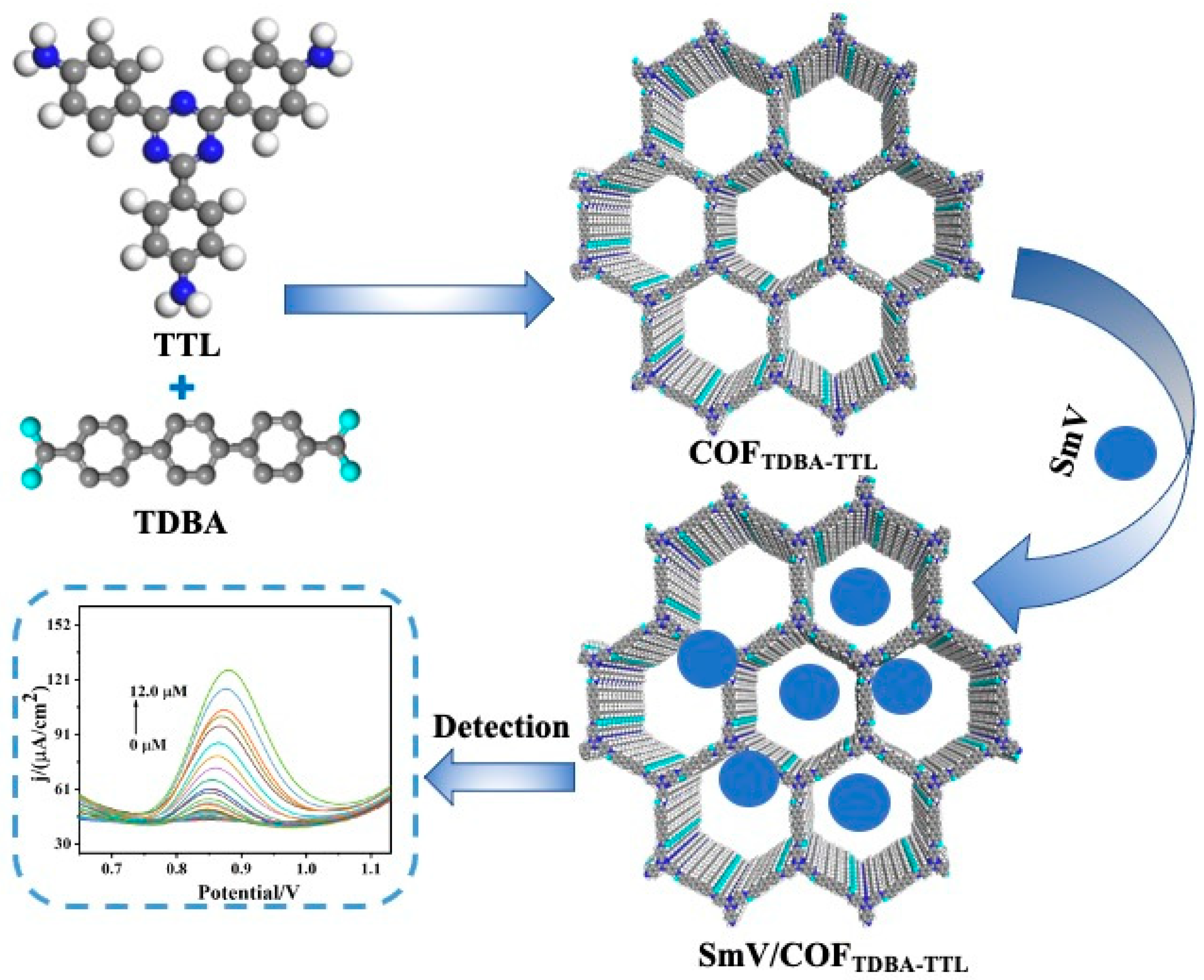
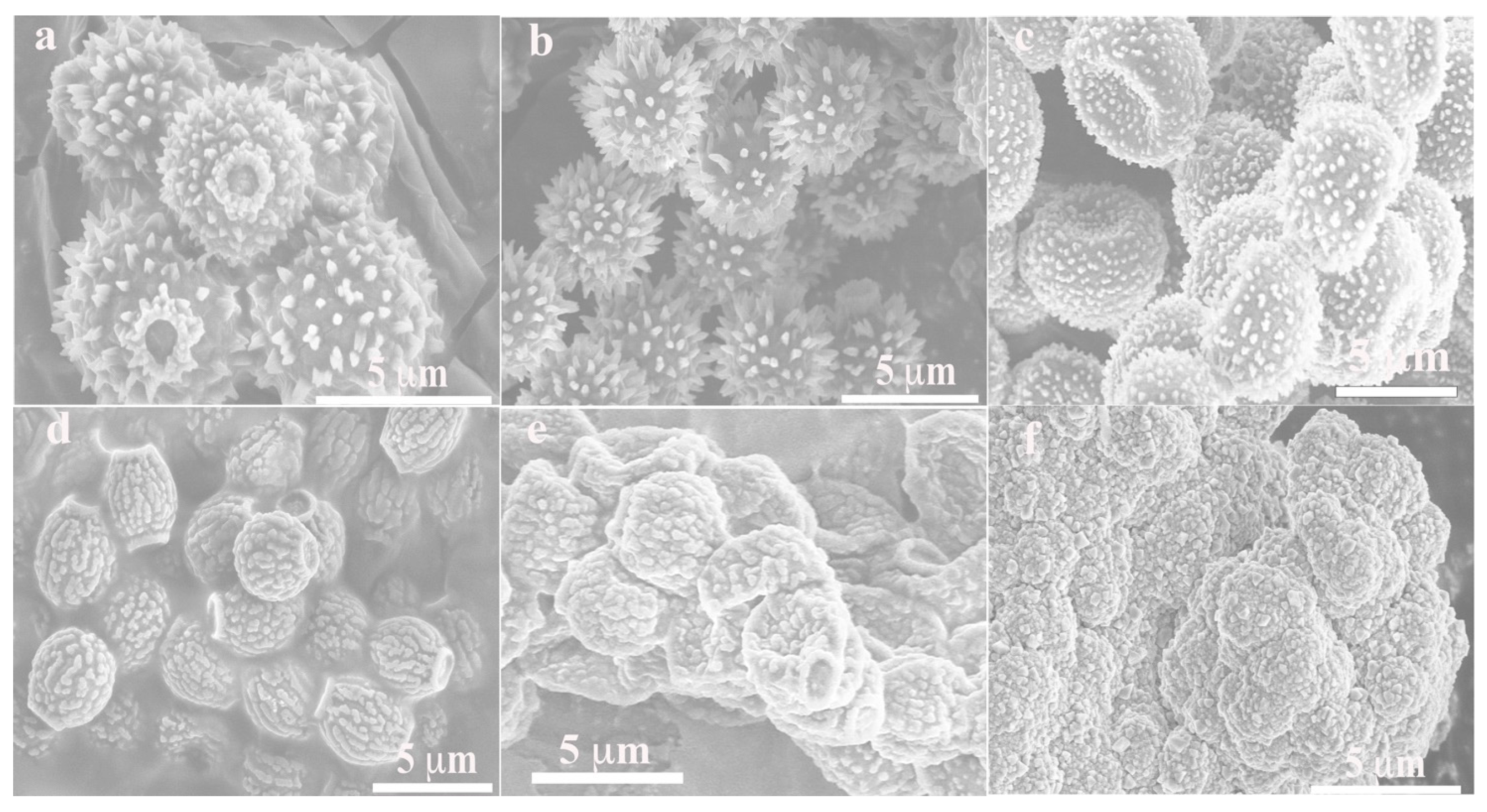
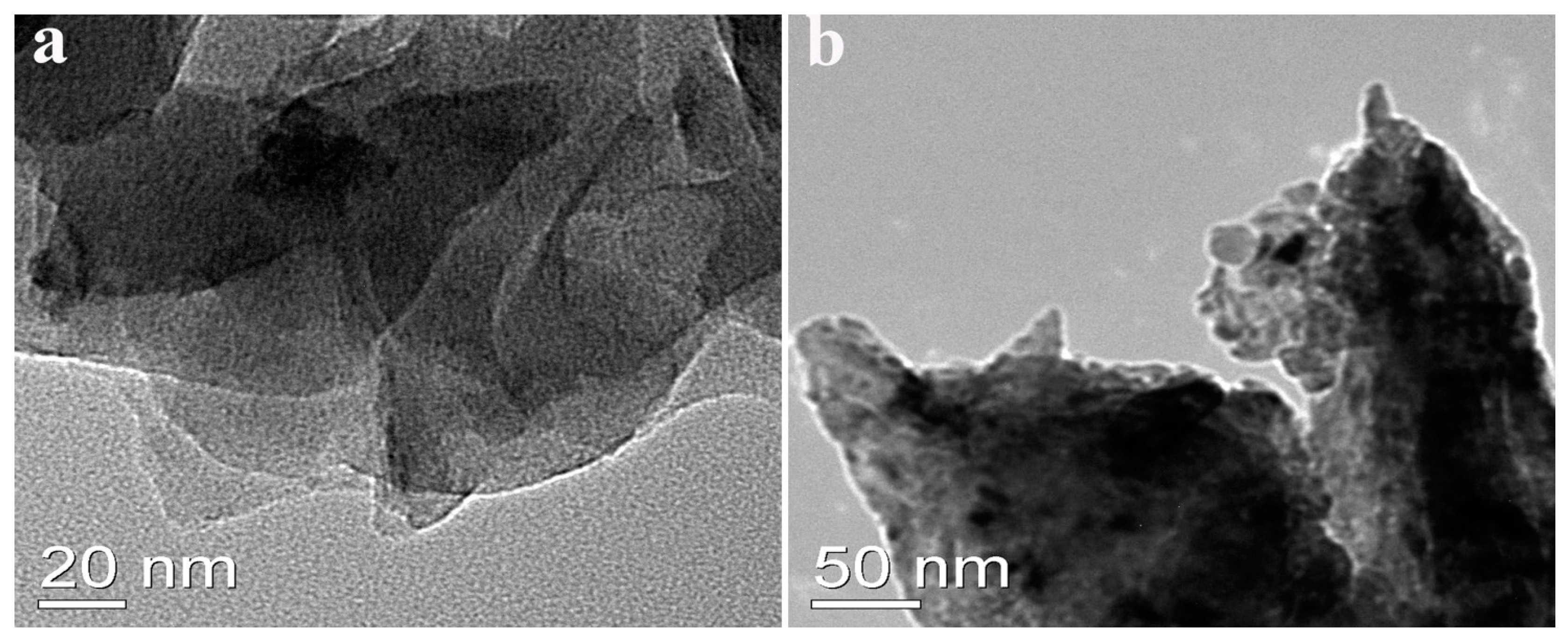

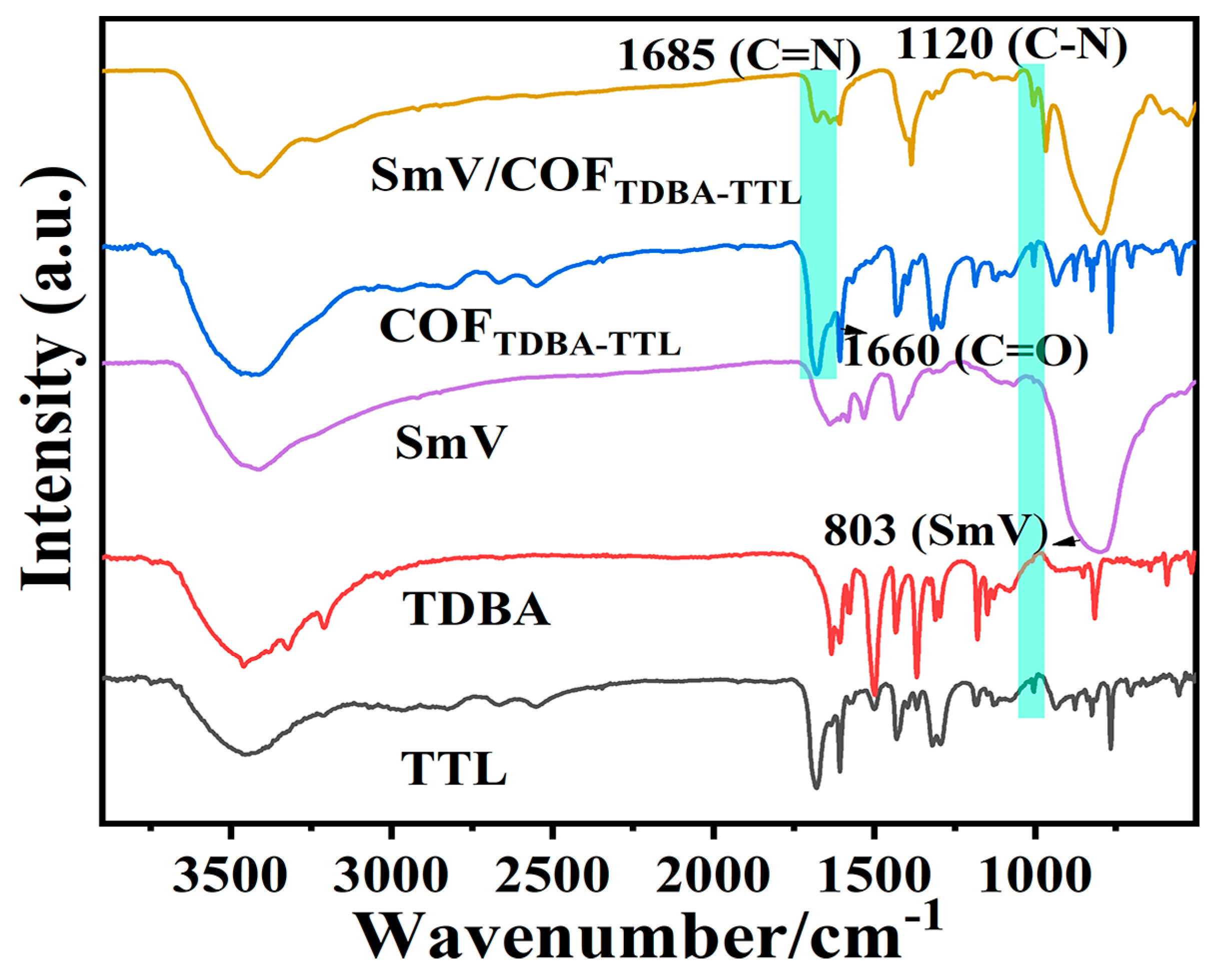

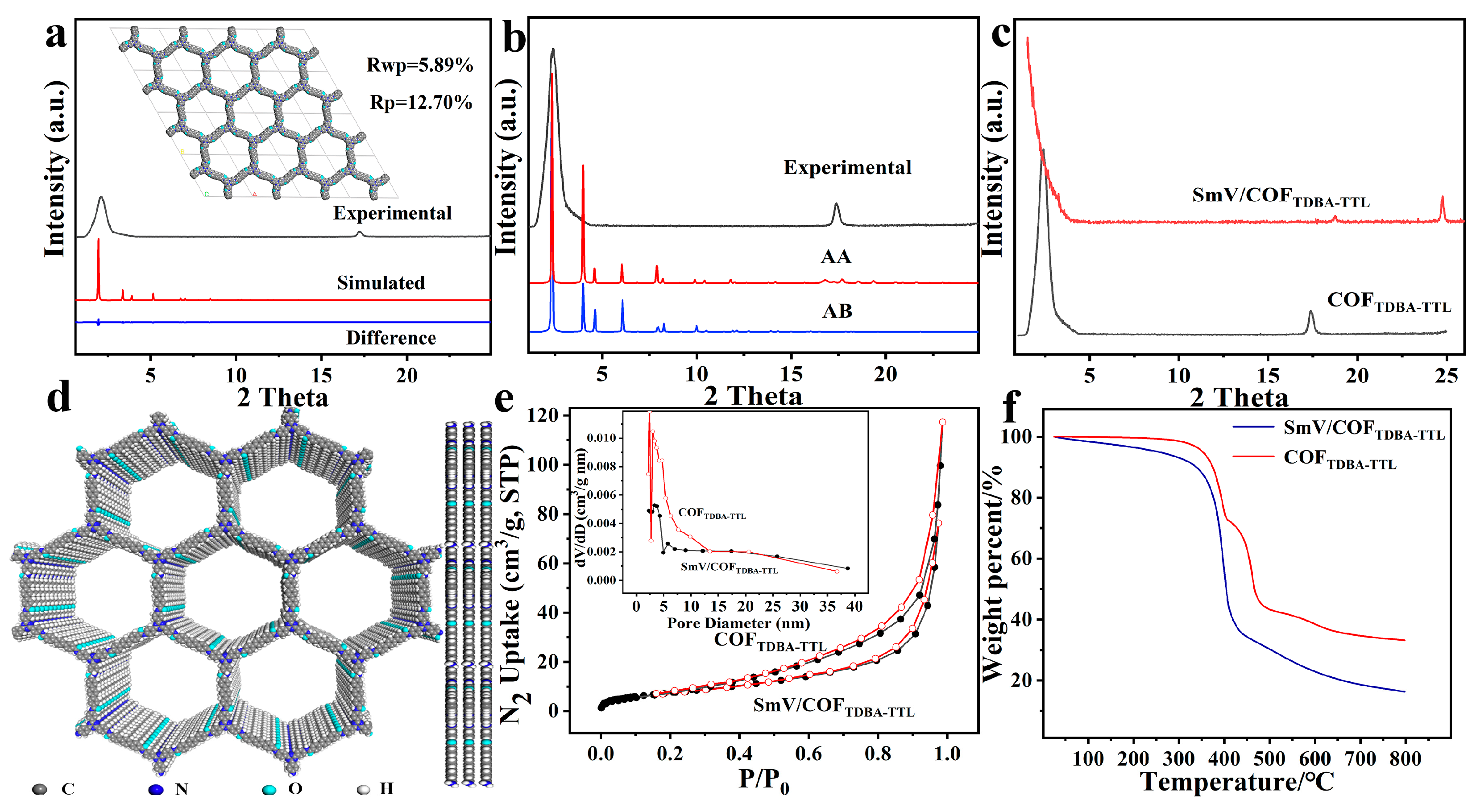

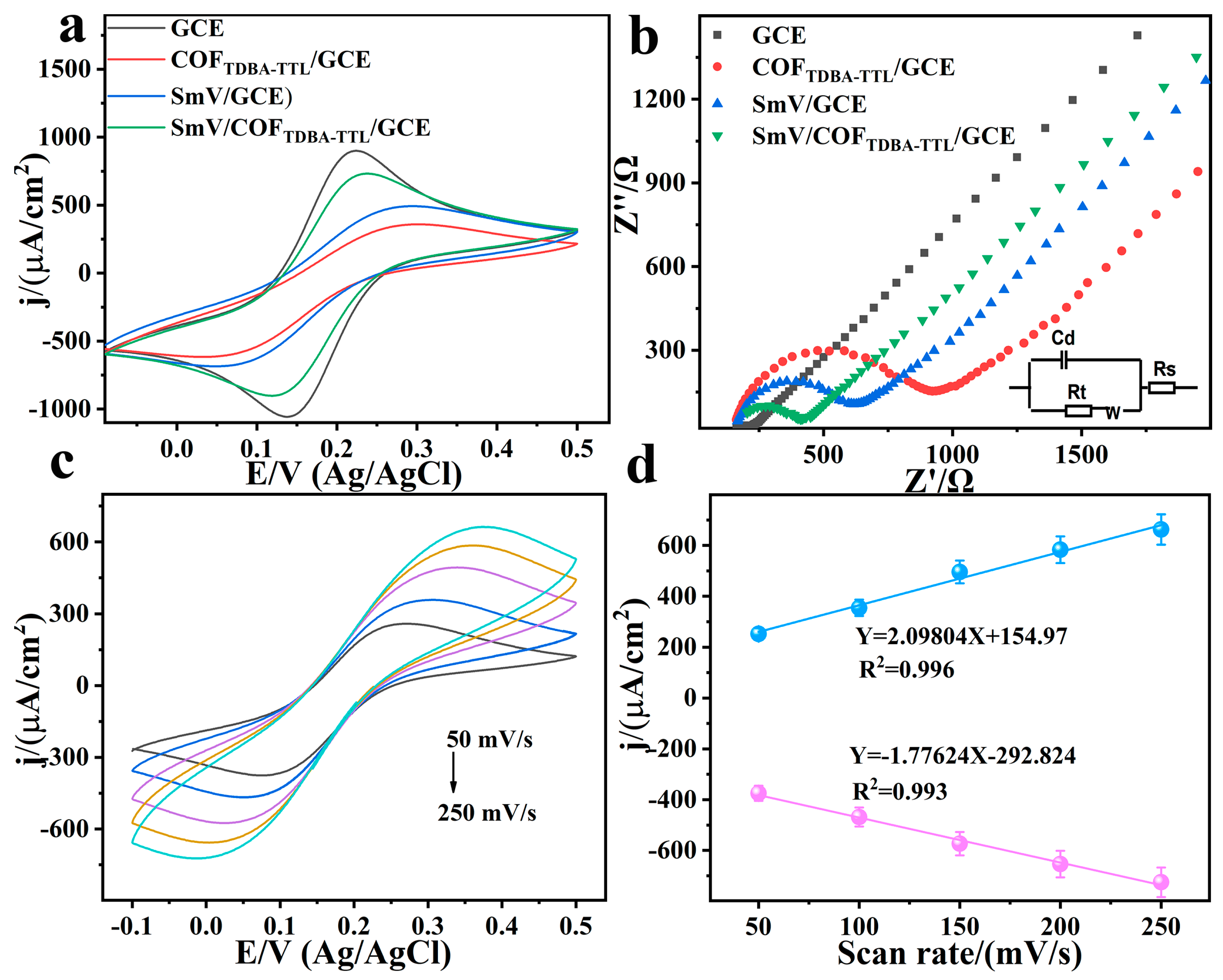
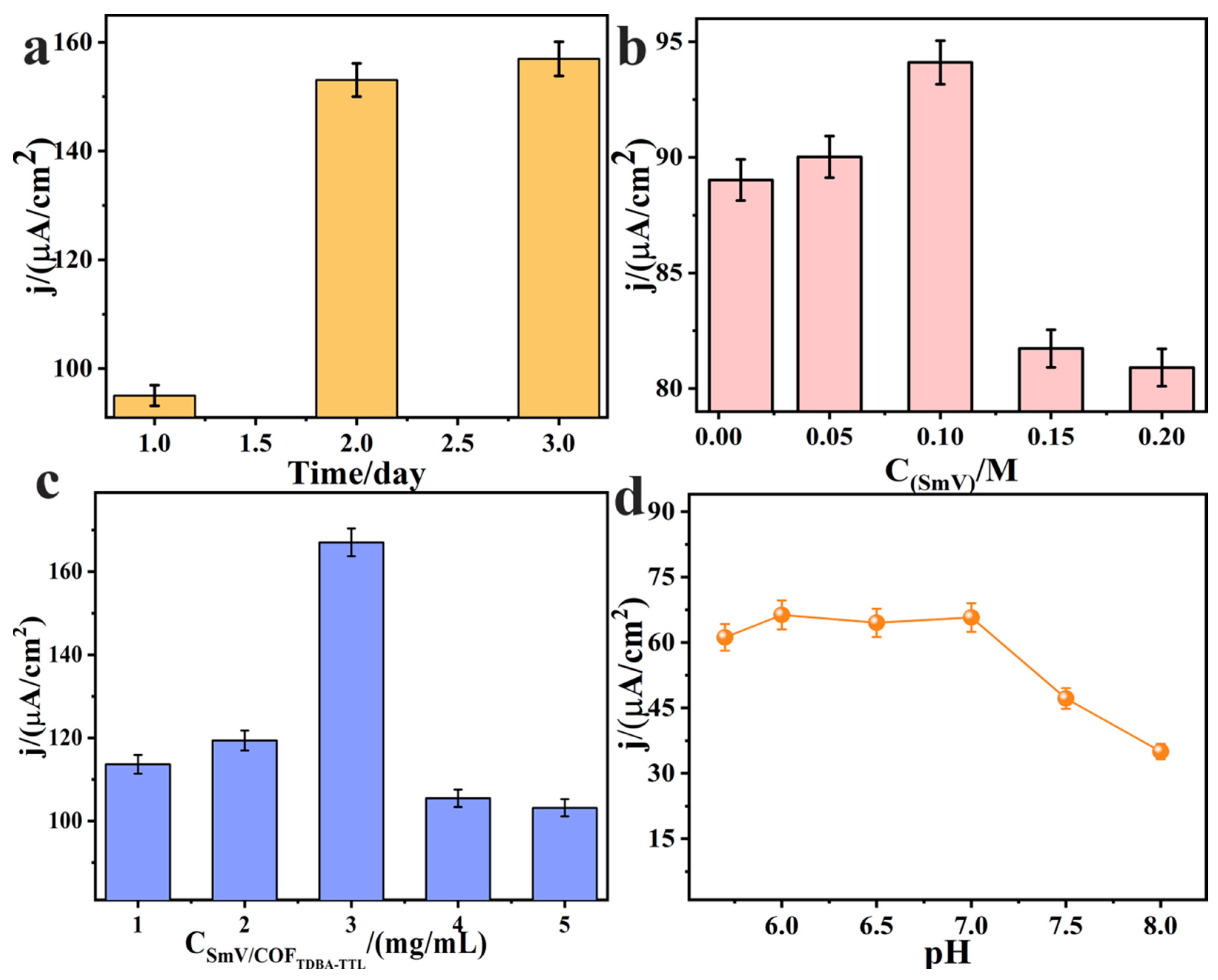
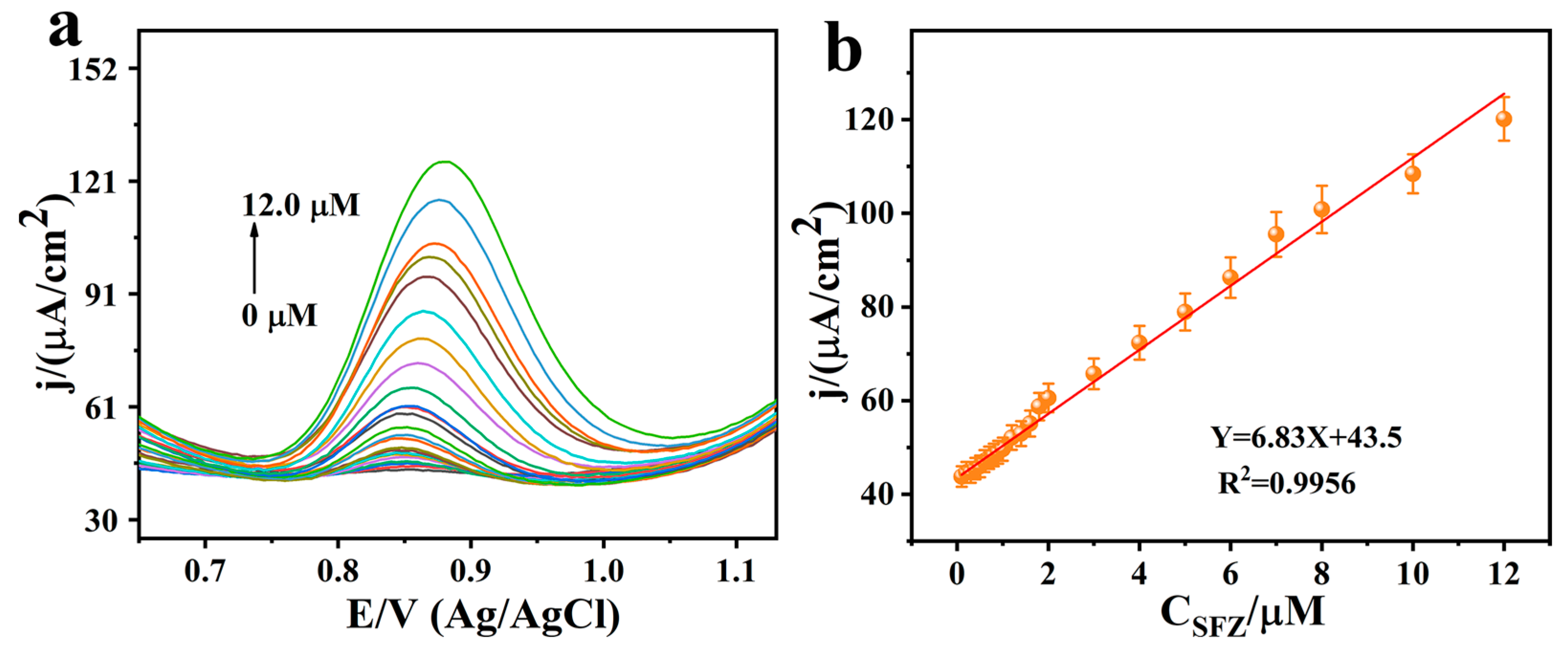
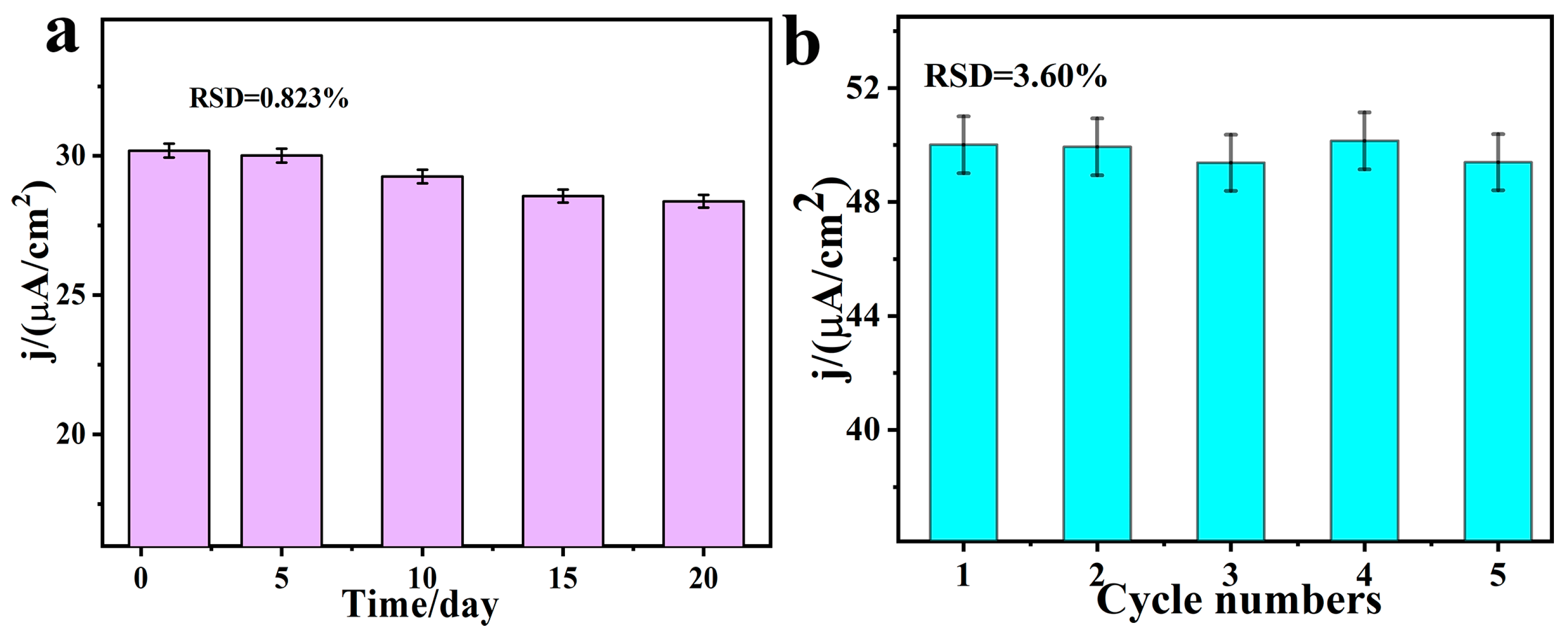
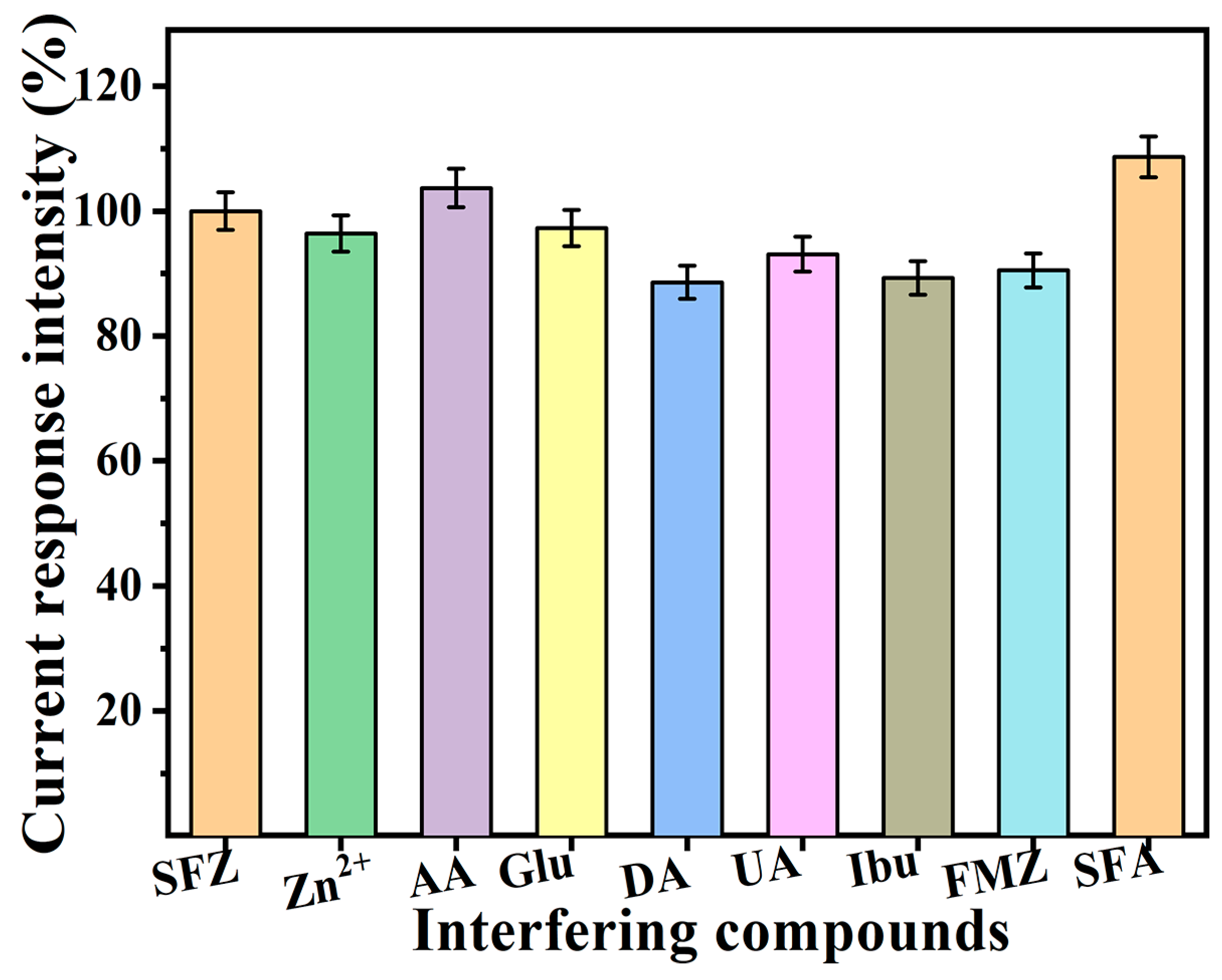
| Electrode Material | Liner Range (μM) | LOD (μM) | Detection Method | Ref. |
|---|---|---|---|---|
| TiC/BN 1 | 0.0100–44.0; 59.0–186 | 0.00300 | DPV | [44] |
| NIP/GO@COF 2 | 0.500–200 | 0.160 | DPV | [50] |
| SmV/CNF 3 | 0.00900–445 | 0.00130 | i-t | [51] |
| ZnO-Co3O4 | 0.00500–18.5 | 0.00120 | Photoelectrochemical | [9] |
| Ag NPs-GQDs 4 | 0.0400–22.0 | 0.0100 | Fluorescence | [52] |
| Cu2Sb | 0.0900–818 | 0.0700 | DPV | [53] |
| GCE | 20.0–300 | 6.14 | DPV | [54] |
| LaCe NPs | 0.0400–1525 | 0.0500 | CV | [55] |
| SmV/COFTDBA-TTL/GCE | 0.00732–12.0; | 0.00240 | SWV | This work |
| Samples | Original (μM) | Added (μM) | Detected (μM) | Recovery (%) |
|---|---|---|---|---|
| Tilapia 1 | - | 5.00 | 5.50 | 110 |
| Tilapia 2 | - | 5.00 | 4.77 | 95.4 |
| Tilapia 3 | - | 5.00 | 5.50 | 110 |
| Tilapia 4 | - | 5.00 | 4.90 | 98.0 |
| Tilapia 5 | - | 5.00 | 4.49 | 89.8 |
| Tilapia 6 | - | 5.00 | 5.10 | 102 |
| Tilapia 7 | - | 5.00 | 4.91 | 98.2 |
| Tilapia 8 | - | 5.00 | 5.30 | 106 |
Disclaimer/Publisher’s Note: The statements, opinions and data contained in all publications are solely those of the individual author(s) and contributor(s) and not of MDPI and/or the editor(s). MDPI and/or the editor(s) disclaim responsibility for any injury to people or property resulting from any ideas, methods, instructions or products referred to in the content. |
© 2023 by the authors. Licensee MDPI, Basel, Switzerland. This article is an open access article distributed under the terms and conditions of the Creative Commons Attribution (CC BY) license (https://creativecommons.org/licenses/by/4.0/).
Share and Cite
Han, J.; Liao, Z.; Chen, G.; Qiu, J.; Zhu, F. A Novel Rare Earth and Covalent Organic Framework Composite for Rapid and Highly Sensitive Electrochemical Analysis of Sulfadiazine in Fish Muscle. Chemosensors 2023, 11, 277. https://doi.org/10.3390/chemosensors11050277
Han J, Liao Z, Chen G, Qiu J, Zhu F. A Novel Rare Earth and Covalent Organic Framework Composite for Rapid and Highly Sensitive Electrochemical Analysis of Sulfadiazine in Fish Muscle. Chemosensors. 2023; 11(5):277. https://doi.org/10.3390/chemosensors11050277
Chicago/Turabian StyleHan, Jiajia, Zicong Liao, Guosheng Chen, Junlang Qiu, and Fang Zhu. 2023. "A Novel Rare Earth and Covalent Organic Framework Composite for Rapid and Highly Sensitive Electrochemical Analysis of Sulfadiazine in Fish Muscle" Chemosensors 11, no. 5: 277. https://doi.org/10.3390/chemosensors11050277





